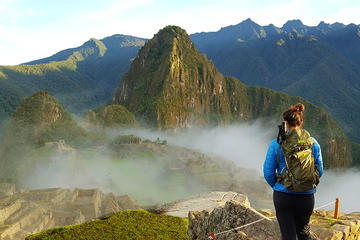
Valparaíso, Chile
by W. Ruth Kozak
She is affectionately known as “La Dama Blanca”, the White Lady, but a sinister past has marked her with a blemish she can’t seem to live down.
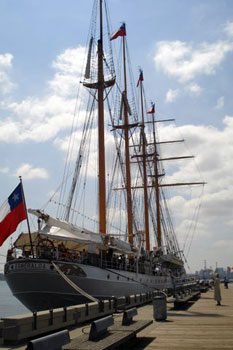 La Esmeralda, a stately four-masted barquentine, pride of the Chilean Navy, was built in Cadiz, Spain in 1946 and was to become Spain’s national training ship. Due to several explosions at the shipyards, work was halted and eventually she was sold to Chile to help pay off debts incurred as a result of the Spanish Civil War. She was officially launched in 1953. Esmeralda is now a training ship for the Chilean Navy, visiting ports worldwide as a floating embassy for Chile.
La Esmeralda, a stately four-masted barquentine, pride of the Chilean Navy, was built in Cadiz, Spain in 1946 and was to become Spain’s national training ship. Due to several explosions at the shipyards, work was halted and eventually she was sold to Chile to help pay off debts incurred as a result of the Spanish Civil War. She was officially launched in 1953. Esmeralda is now a training ship for the Chilean Navy, visiting ports worldwide as a floating embassy for Chile.
She is the sixth ship to carry the name “Esmeralda”. The first was a frigate, captured from the Spanish at Callao Peru in November 1820. The second was a Chilean corvette that fought a fierce sea battle in May 1879 at the Battle of Iquique and sank with colors flying. These historical events are important milestones for the Chilean Navy and the name “La Esmeralda” evoked courage and sacrifice.
 Unfortunately La Esmeralda’s reputation was sullied during the infamous Augusto Pinochet regime from 1973 to 1980 when she was used as a floating jail and torture chamber for political prisoners. The Chilean Navy was the advance guard of Augusto Pinochet’s coup and after the overthrow of Salvador Allende’s democratically elected socialist government, naval patrols scoured the streets of Valparaiso broadcasting the names of people demanding them to hand themselves in. Among them was an Anglo-Chilean priest, Father Michael Woodward. He was arrested at his home by a naval patrol and taken to the headquarters of the local Carabineros where he was brutally assaulted, then transferred to La Esmeralda where he was reputedly tortured and died. Doctors claimed he had died of a heart attack and the navy refused to give him a proper burial but dumped his body in a mass grave. Michael Woodward was one of the most prominent of those tortured on the ship. Several hundred other detainees, sympathizers of the ousted socialist president Allende, were taken there and suffered various fates including beatings, sexual assaults, electrocution and water torture. Consequently these days when she sails into port, crowds of protestors – political groups and Chilean exiles –gather demanding retribution in the form of a formal apology from the Chilean government and request that a plaque in the shape of a dove be put on the ship bearing the names of the victims. To date, these requests have been refused.
Unfortunately La Esmeralda’s reputation was sullied during the infamous Augusto Pinochet regime from 1973 to 1980 when she was used as a floating jail and torture chamber for political prisoners. The Chilean Navy was the advance guard of Augusto Pinochet’s coup and after the overthrow of Salvador Allende’s democratically elected socialist government, naval patrols scoured the streets of Valparaiso broadcasting the names of people demanding them to hand themselves in. Among them was an Anglo-Chilean priest, Father Michael Woodward. He was arrested at his home by a naval patrol and taken to the headquarters of the local Carabineros where he was brutally assaulted, then transferred to La Esmeralda where he was reputedly tortured and died. Doctors claimed he had died of a heart attack and the navy refused to give him a proper burial but dumped his body in a mass grave. Michael Woodward was one of the most prominent of those tortured on the ship. Several hundred other detainees, sympathizers of the ousted socialist president Allende, were taken there and suffered various fates including beatings, sexual assaults, electrocution and water torture. Consequently these days when she sails into port, crowds of protestors – political groups and Chilean exiles –gather demanding retribution in the form of a formal apology from the Chilean government and request that a plaque in the shape of a dove be put on the ship bearing the names of the victims. To date, these requests have been refused.
I was invited aboard La Esmeralda for a reception,”Flavours of Chile”, presented by the Chilean Trade Commissioner. At the time I had no idea of the ship’s dark history but it made my visit somewhat more meaningful, because I wanted to learn more and see the ship for myself. I expected to find the wharf crowded with protestors but when I arrived there were none. I was greeted aboard by a couple of handsome young officers and from there to the reception area on the deck where tables of various Chilean wines were offered as samples as well as the plates of delicious Chilean appetizers brought round by the stewards.
 The ship itself truly is a beauty, a four-masted tall ship, one of the tallest and longest ships in the world. She has a crew of 300 sailors and 90 midshipmen, 46 of them women. Marcia, one of the lovely young female officers, took my friend and I around on a tour of the deck area, and explained the functions of the various pieces of equipment on board. The ship is spotless, the wooden decks polished and unmarred, the brass fittings shining in the afternoon sun. She pointed out the 21 sails and explained how every morning at 6 a.m. the trainees must climb to the top of the centre mast. If they falter or make a mistake they must do it again at noon. And if they make a bad error they must climb it again and again to get it right. She showed us the tasks she is responsible for every day as well as climbing up to secure the sails, although being a tall girl she only has to go part way up to do that. The shorter crew members are the ones who climb to the very top, a daunting job that not many people would have the courage to participate in.
The ship itself truly is a beauty, a four-masted tall ship, one of the tallest and longest ships in the world. She has a crew of 300 sailors and 90 midshipmen, 46 of them women. Marcia, one of the lovely young female officers, took my friend and I around on a tour of the deck area, and explained the functions of the various pieces of equipment on board. The ship is spotless, the wooden decks polished and unmarred, the brass fittings shining in the afternoon sun. She pointed out the 21 sails and explained how every morning at 6 a.m. the trainees must climb to the top of the centre mast. If they falter or make a mistake they must do it again at noon. And if they make a bad error they must climb it again and again to get it right. She showed us the tasks she is responsible for every day as well as climbing up to secure the sails, although being a tall girl she only has to go part way up to do that. The shorter crew members are the ones who climb to the very top, a daunting job that not many people would have the courage to participate in.
None of these young trainees and likely many of the senior crew would not have been born at the time of Pinochet’s brutal regime when the atrocities were carried out on board the ship. In fact, there were no ‘bad vibes’ aboard, only the friendly smiling crew who mingled with the guests and greeted us all with Chilean warmth. But for those who had suffered torture or had loved ones die aboard her, the stigma will remain, and it’s a staunch reminder that political prisoner abuse and torture are not things of the past. Perhaps one day, the condor, a bird of prey, that decorates her bow will be replaced with a dove, the symbol of peace, but to date it remains to be seen if the Chilean Navy will ever admit to all the facts about La Esmeralda.
Other Information About La Esmeralda
Official web site: www.esmeralda.cl
Documentary film “The Dark Side of the White Lady”: www.nfb.ca
Virtual Tour on Esmeralda: www.Chilexplora.com
“Una Vida Verdadera: El Sacrificio de Miquel Woodward” by Andres Brignardello and Jose Acevedo (documentary)
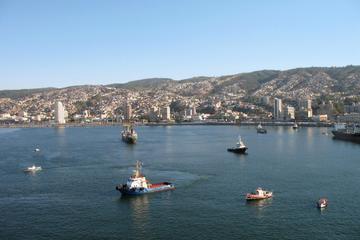
Valparaiso Like a Local: Private Walking Tour with Harbor Cruise Including Transport from Santiago
About the author:
Ruth is an avid traveler and has always felt a romantic attachment to sailing ships. She has also visited Chile and is well informed of the events that happened during the brutal regime of Augusto Pinochet. Her visit to La Esmeralda was a memorial to Chilean friends she knows who fled their homeland as exiles, and in this article as well as her blog about Esmeralda at http://travelthroughhistory.blogspot.com is in memory of those who suffered and died on this ship. www.ruthkozak.com
Photo credits:
Top photo by United States Navy, Photographer’s Mate 1st Class Dennis C. Cantrell / Public domain
All other photos by W. Ruth Kozak.


 The town of Pisac (elevation about 9,500 ft) has a central market that is frequently visited by tour buses on their way to the ruins on the hills above Pisac. Most tours stop at the craft market and then head up to the ruins for the morning, and then move on down the Sacred Valley to other archaeological sites. From the town of Pisac, you can view the ancient Inca terraces far up on the steep hillsides. Looking up the steep slopes from Pisac, it is hard to imagine walking up the steep slopes of the mountains to labor making stone terraces and farm these remote and high fields, but evidently the Inca did it. In the ancient construction of the agricultural terraces included both normal stairs and stones inserted into the walls to allow them to move up through the terraces as they tended their crops on the high slopes.
The town of Pisac (elevation about 9,500 ft) has a central market that is frequently visited by tour buses on their way to the ruins on the hills above Pisac. Most tours stop at the craft market and then head up to the ruins for the morning, and then move on down the Sacred Valley to other archaeological sites. From the town of Pisac, you can view the ancient Inca terraces far up on the steep hillsides. Looking up the steep slopes from Pisac, it is hard to imagine walking up the steep slopes of the mountains to labor making stone terraces and farm these remote and high fields, but evidently the Inca did it. In the ancient construction of the agricultural terraces included both normal stairs and stones inserted into the walls to allow them to move up through the terraces as they tended their crops on the high slopes.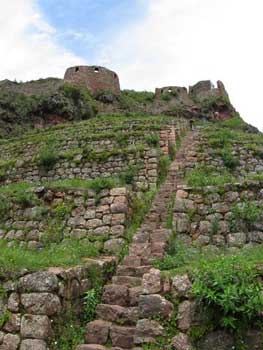 The next morning after arriving in town, finding a place to stay and getting some food for the hike, we set out up the stairs leading from town to the first set of terraces. We headed through the market stalls selling colorful alpaca wool shawls, blankets and hats, stopping to barter and eventually buy some woolen hats to ward off the chill of the thin mountain air. Leaving the market by a small back street passing between mud wall compounds and heading towards the steep slopes at the edge of town, we walked over the cobblestones of a path which led up towards the first ascent into the terraces above the village.
The next morning after arriving in town, finding a place to stay and getting some food for the hike, we set out up the stairs leading from town to the first set of terraces. We headed through the market stalls selling colorful alpaca wool shawls, blankets and hats, stopping to barter and eventually buy some woolen hats to ward off the chill of the thin mountain air. Leaving the market by a small back street passing between mud wall compounds and heading towards the steep slopes at the edge of town, we walked over the cobblestones of a path which led up towards the first ascent into the terraces above the village.
 Fortunately, we had been at high elevations for over a week to allow our bodies enough time to adjust to the elevation and thin mountain air, so the climb did not cause any altitude sickness. As we steadily climbed the hill, breathing heavily as we strained to extract oxygen from the cool and crisp morning air, we climbed a long series of stairs up between two small guard towers. We continued through the high farm terraces and into the ruins of small settlement on the steep slopes where the buildings had been laid out to form the shape of a bird when viewed from above. Then we climbed up to the ceremonial center of Intihuatana within the ruins.
Fortunately, we had been at high elevations for over a week to allow our bodies enough time to adjust to the elevation and thin mountain air, so the climb did not cause any altitude sickness. As we steadily climbed the hill, breathing heavily as we strained to extract oxygen from the cool and crisp morning air, we climbed a long series of stairs up between two small guard towers. We continued through the high farm terraces and into the ruins of small settlement on the steep slopes where the buildings had been laid out to form the shape of a bird when viewed from above. Then we climbed up to the ceremonial center of Intihuatana within the ruins. From the ceremonial center, we moved up through an Inca tunnel carved into the rocky mountain top, along a defensive wall beneath military barracks (where they guarded the main entrance) and into a saddle that had sacred baths and views of cliff sides with burial caves in them. Since the caves have been hit by grave robbers, tourists are not allowed into that area. We finished by going to the tour bus drop off area to get a some fresh squeezed orange juice before heading back down into town. In addition to the sense of accomplishment from having climbed all the way up (11,200 feet above see level) from town (over 1,700 feet of elevation gain) we got to visit the site in the opposite direction as the flow of the tour groups, and we could not help but feel a little smug as tourists huffed and puffed their way back to the bus parking area after their short tour, loudly complaining about the short hike.
From the ceremonial center, we moved up through an Inca tunnel carved into the rocky mountain top, along a defensive wall beneath military barracks (where they guarded the main entrance) and into a saddle that had sacred baths and views of cliff sides with burial caves in them. Since the caves have been hit by grave robbers, tourists are not allowed into that area. We finished by going to the tour bus drop off area to get a some fresh squeezed orange juice before heading back down into town. In addition to the sense of accomplishment from having climbed all the way up (11,200 feet above see level) from town (over 1,700 feet of elevation gain) we got to visit the site in the opposite direction as the flow of the tour groups, and we could not help but feel a little smug as tourists huffed and puffed their way back to the bus parking area after their short tour, loudly complaining about the short hike.
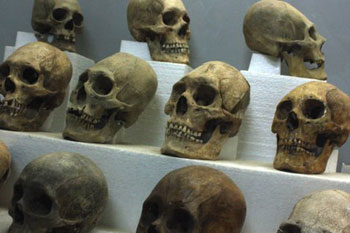
 Old Tiwanaku covered at least 30 hectares; the vast majority of the site has yet to be excavated. The most outstanding structure, the Pyramid of Akapana, was constructed during the Classical Age of Tiwanaku Culture around 300 CE. At 18 meters high, this square structure consists of seven stacked platforms set over a natural hill. The present structure had to be partly reconstructed because the Spanish conquistador Oyardeburu’s demolition crew had haphazardly searched for treasure inside.
Old Tiwanaku covered at least 30 hectares; the vast majority of the site has yet to be excavated. The most outstanding structure, the Pyramid of Akapana, was constructed during the Classical Age of Tiwanaku Culture around 300 CE. At 18 meters high, this square structure consists of seven stacked platforms set over a natural hill. The present structure had to be partly reconstructed because the Spanish conquistador Oyardeburu’s demolition crew had haphazardly searched for treasure inside.
 The Akapana Pyramid appears to have been multi-purpose. According to Miguel, the summit was an observatory. The astronomers worked within the bounds of a shallow, sunken, chamber open to the sky. This chamber was once shaped like an Andean Cross; a stepped-cross made up of an equal-armed cross indicating the cardinal points of the compass and a superimposed square. This cross symbolizes the three levels of heaven, earth and underworld. Needless to say, you require some imagination to see this figure. The summit holds the remains of a house whose rooms were used for preparing ritual ceremonies involving human sacrifice to the sun.
The Akapana Pyramid appears to have been multi-purpose. According to Miguel, the summit was an observatory. The astronomers worked within the bounds of a shallow, sunken, chamber open to the sky. This chamber was once shaped like an Andean Cross; a stepped-cross made up of an equal-armed cross indicating the cardinal points of the compass and a superimposed square. This cross symbolizes the three levels of heaven, earth and underworld. Needless to say, you require some imagination to see this figure. The summit holds the remains of a house whose rooms were used for preparing ritual ceremonies involving human sacrifice to the sun. Descend the pyramid and move toward the nearby Kalasasaya Temple platform. The walls of the platform include huge red sandstone and andesite blocks, some of which weigh as much as 100 tons. The nearest andesite quarries are located at Copacabana – 40 kilometers distant. The sandstone quarries were only 10 kilometers away. The massive blocks were transported to Tiwanaku using wooden boats.
Descend the pyramid and move toward the nearby Kalasasaya Temple platform. The walls of the platform include huge red sandstone and andesite blocks, some of which weigh as much as 100 tons. The nearest andesite quarries are located at Copacabana – 40 kilometers distant. The sandstone quarries were only 10 kilometers away. The massive blocks were transported to Tiwanaku using wooden boats. The mere eight-foot climb to the top of Tiwanaku’s most sacred temple also leaves you short-of-breath. At the top of the platform to your left is the National Symbol of Bolivia – the Gate of the Sun (Puerta del Sol). Weighting three tons, this gate is carved from a single slab of andesite. The crack in the lintel occurred when the gate was moved from its original location near the center of the platform.
The mere eight-foot climb to the top of Tiwanaku’s most sacred temple also leaves you short-of-breath. At the top of the platform to your left is the National Symbol of Bolivia – the Gate of the Sun (Puerta del Sol). Weighting three tons, this gate is carved from a single slab of andesite. The crack in the lintel occurred when the gate was moved from its original location near the center of the platform. Contrasting with the raised Kalasasaya Temple, the open- air Semisubterranean Temple is 2 meters below ground level. Descending a shallow set of stairs into the open-air room, you find yourself surrounded by 175 stone faces jutting out from the walls; they might be sizing you up as the next potential sacrifice. Each of these well-worn limestone faces is unique and might possibly represent the different tribes/peoples living within the empire of Tiwanku. At its zenith, the empire stretched from present-day northwest Argentina to northern Chile. On the other hand, Miguel did refer to one of the faces as “an alien”. Perhaps the empire is a little larger than originally believed.
Contrasting with the raised Kalasasaya Temple, the open- air Semisubterranean Temple is 2 meters below ground level. Descending a shallow set of stairs into the open-air room, you find yourself surrounded by 175 stone faces jutting out from the walls; they might be sizing you up as the next potential sacrifice. Each of these well-worn limestone faces is unique and might possibly represent the different tribes/peoples living within the empire of Tiwanku. At its zenith, the empire stretched from present-day northwest Argentina to northern Chile. On the other hand, Miguel did refer to one of the faces as “an alien”. Perhaps the empire is a little larger than originally believed. Next door, the Ceramic Museum outlines the Tiwanaku culture from its origins as a village circa 1580 BCE to the demise of the empire around 1200 CE, possibly the result of a prolonged drought and a receding Lake Titicaca.
Next door, the Ceramic Museum outlines the Tiwanaku culture from its origins as a village circa 1580 BCE to the demise of the empire around 1200 CE, possibly the result of a prolonged drought and a receding Lake Titicaca.
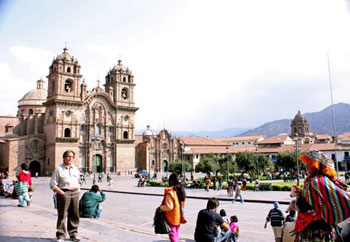
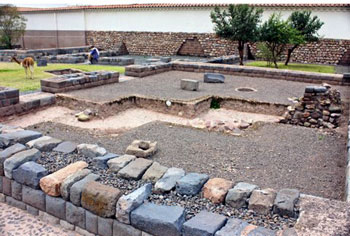 The very Spanish-looking Plaza de Armas was once surrounded by Inca palaces but now it is a holy square. The Cathedral, flanked by two lesser churches, is the focal point. The conquerors disassembled the Palace of Viracocha and re-used its gray stone blocks in the Cathedral as walls and supporting columns.
The very Spanish-looking Plaza de Armas was once surrounded by Inca palaces but now it is a holy square. The Cathedral, flanked by two lesser churches, is the focal point. The conquerors disassembled the Palace of Viracocha and re-used its gray stone blocks in the Cathedral as walls and supporting columns.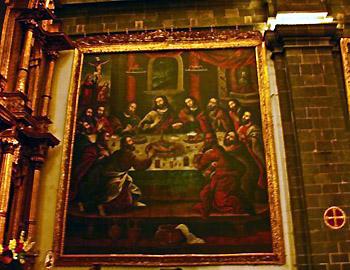 The cathedral also contains over 400 colonial paintings. The most interesting is “The Last Supper” where the main course is guinea pig and a local corn beer called chicha. At the bottom of the painting, to the right of center, Conquistador Francisco Pizarro sits as Judas.
The cathedral also contains over 400 colonial paintings. The most interesting is “The Last Supper” where the main course is guinea pig and a local corn beer called chicha. At the bottom of the painting, to the right of center, Conquistador Francisco Pizarro sits as Judas. Novice nuns were trained at the monastery until 1960. Their bedrooms were filled with personal furnishings that they were expected to provide for themselves as a condition of entry into the Order. Two-foot long cords were hung near their personal crucifixes suggesting that self-flagellation was fashionable at one time.
Novice nuns were trained at the monastery until 1960. Their bedrooms were filled with personal furnishings that they were expected to provide for themselves as a condition of entry into the Order. Two-foot long cords were hung near their personal crucifixes suggesting that self-flagellation was fashionable at one time.
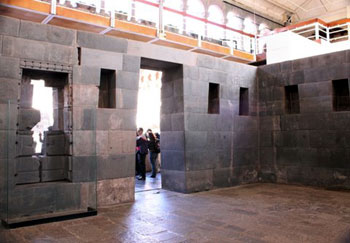 More recently, part of the cloister crumbled during an earthquake thereby exposing four of the original Inca chambers within Qoricancha. The cyclopean walls are striking because of the carefully interlocking stonework. The Incas did not use mortar so as to provide the walls with greater flexibility during an earthquake. This design appears to have functioned very well over time but it was not fool-proof. Past tremors have misaligned a number of stones situated in the upper section of one room.
More recently, part of the cloister crumbled during an earthquake thereby exposing four of the original Inca chambers within Qoricancha. The cyclopean walls are striking because of the carefully interlocking stonework. The Incas did not use mortar so as to provide the walls with greater flexibility during an earthquake. This design appears to have functioned very well over time but it was not fool-proof. Past tremors have misaligned a number of stones situated in the upper section of one room.
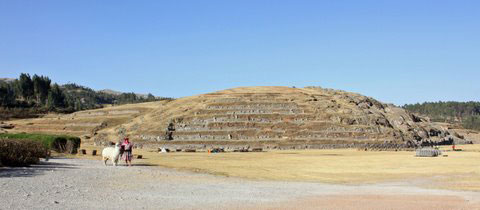
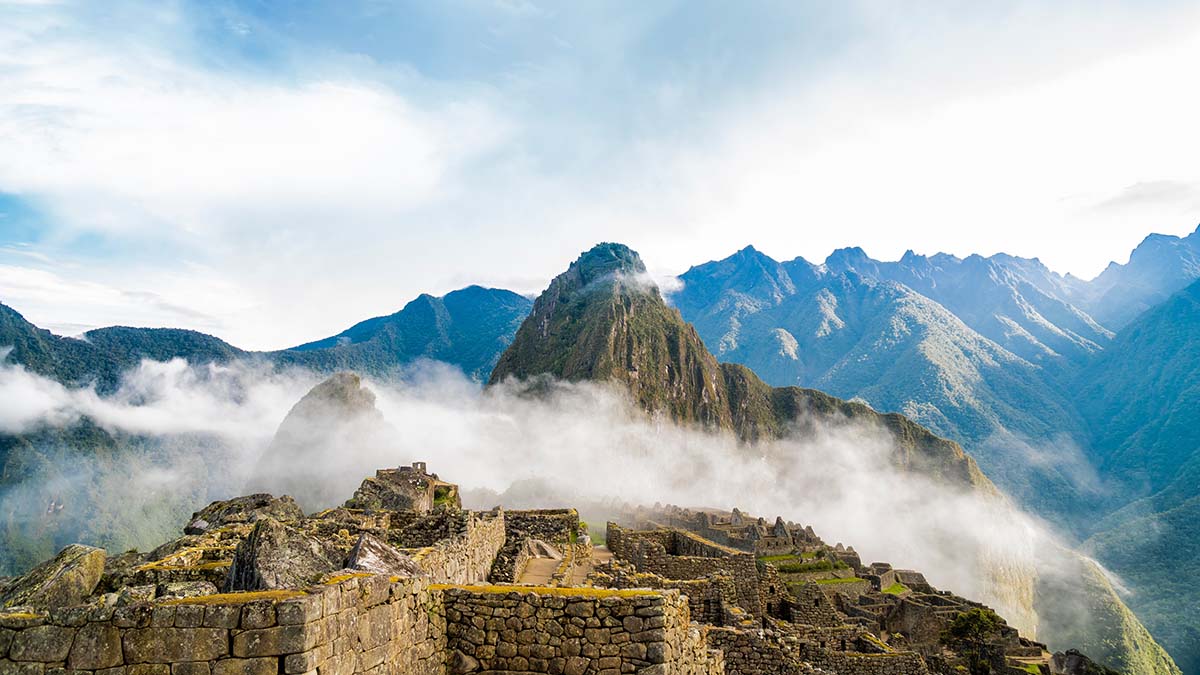
 Coming down into the bulk of the ruins, I walk along the extensive agriculture terraces that flow down the mountainside. They don’t seem to end – eventually the vegetation just thickens and pulls the terraces from my sight. The terrace system has interesting benefits that I, being more familiar with farming on plains, would not have predicted. The terraces vary in temperature as they climb the mountainside. This allowed the farmers to plant various types of crops in their ideal conditions. Also, rain directed nutrients from the higher crops to improve the soil below.
Coming down into the bulk of the ruins, I walk along the extensive agriculture terraces that flow down the mountainside. They don’t seem to end – eventually the vegetation just thickens and pulls the terraces from my sight. The terrace system has interesting benefits that I, being more familiar with farming on plains, would not have predicted. The terraces vary in temperature as they climb the mountainside. This allowed the farmers to plant various types of crops in their ideal conditions. Also, rain directed nutrients from the higher crops to improve the soil below. I enter the ceremonial area, and come upon the Temple of the Sun, a semi-circular temple made with well-worked stones. The stones interlock and hold together without using mortar. This is a common trait of Inca architecture that makes it earthquake-resistant. Inside the structure is a large altar and a trapezoidal window that is thought to have been used for astronomical observation. Below the temple is a cave called the Royal Tomb, even though no human remains have ever been found there.
I enter the ceremonial area, and come upon the Temple of the Sun, a semi-circular temple made with well-worked stones. The stones interlock and hold together without using mortar. This is a common trait of Inca architecture that makes it earthquake-resistant. Inside the structure is a large altar and a trapezoidal window that is thought to have been used for astronomical observation. Below the temple is a cave called the Royal Tomb, even though no human remains have ever been found there. I continue up a staircase past a series of ceremonial baths to a quarry. The scattered boulders seem to emphasize the incomplete nature of Machu Picchu. Despite the extensive work the Incas put into this series of mountaintop structures, they never completed the city.
I continue up a staircase past a series of ceremonial baths to a quarry. The scattered boulders seem to emphasize the incomplete nature of Machu Picchu. Despite the extensive work the Incas put into this series of mountaintop structures, they never completed the city.
 Crossing the central plaza leads me into the residential area of the ruins. It is easy to tell that the stonework is of lower quality than what I saw in the ceremonial area. The structures are simple and domestic, making it easy to imagine people using these stone buildings as houses.
Crossing the central plaza leads me into the residential area of the ruins. It is easy to tell that the stonework is of lower quality than what I saw in the ceremonial area. The structures are simple and domestic, making it easy to imagine people using these stone buildings as houses.